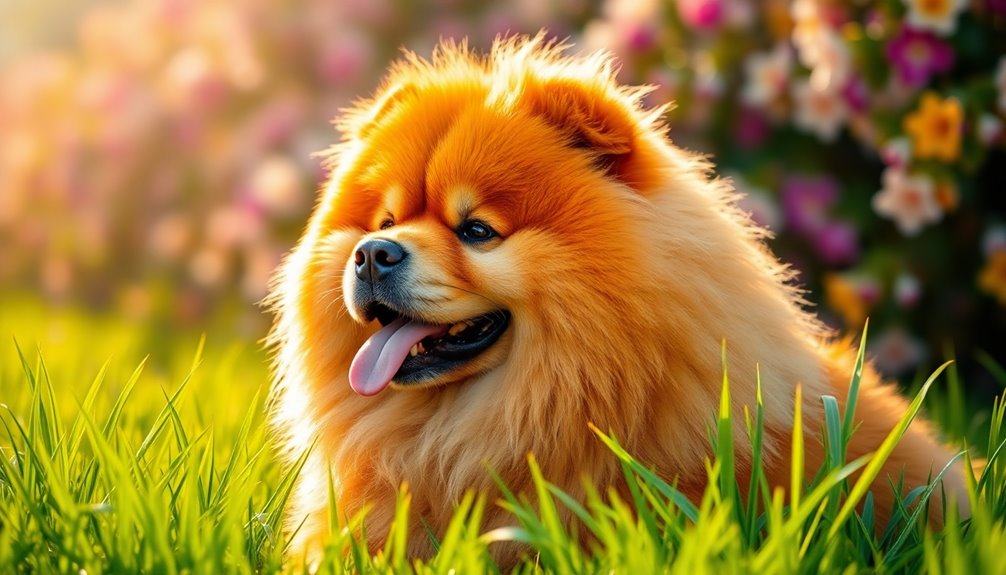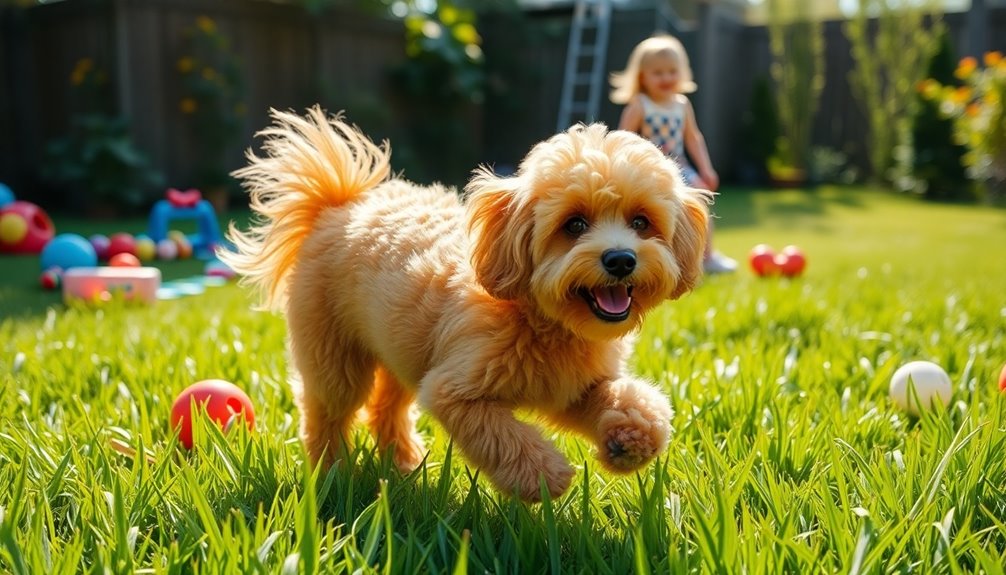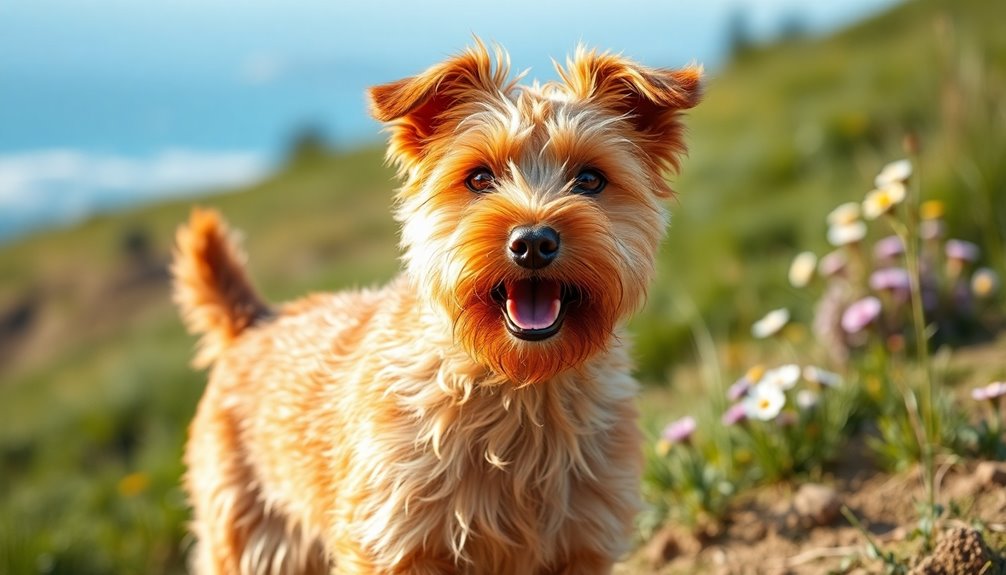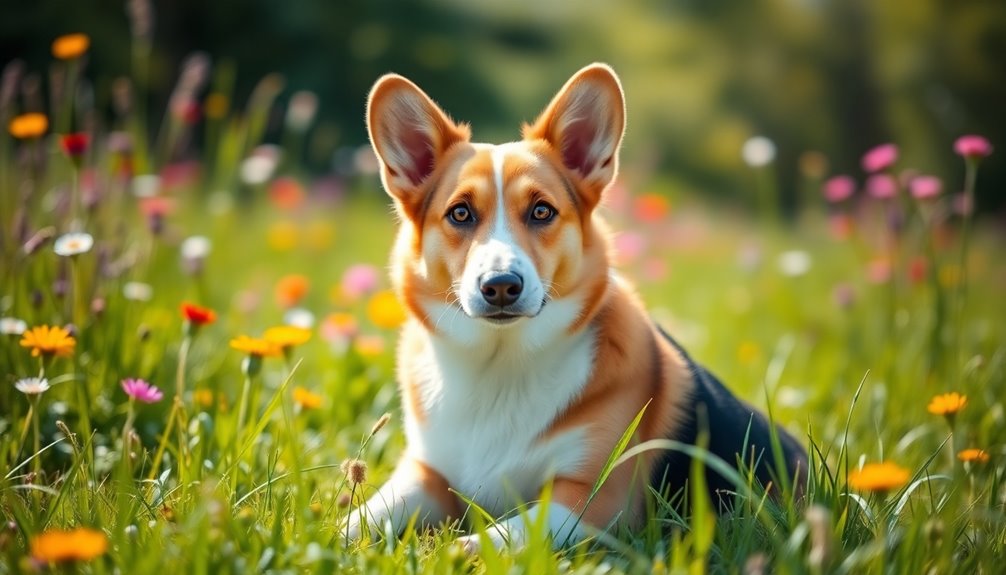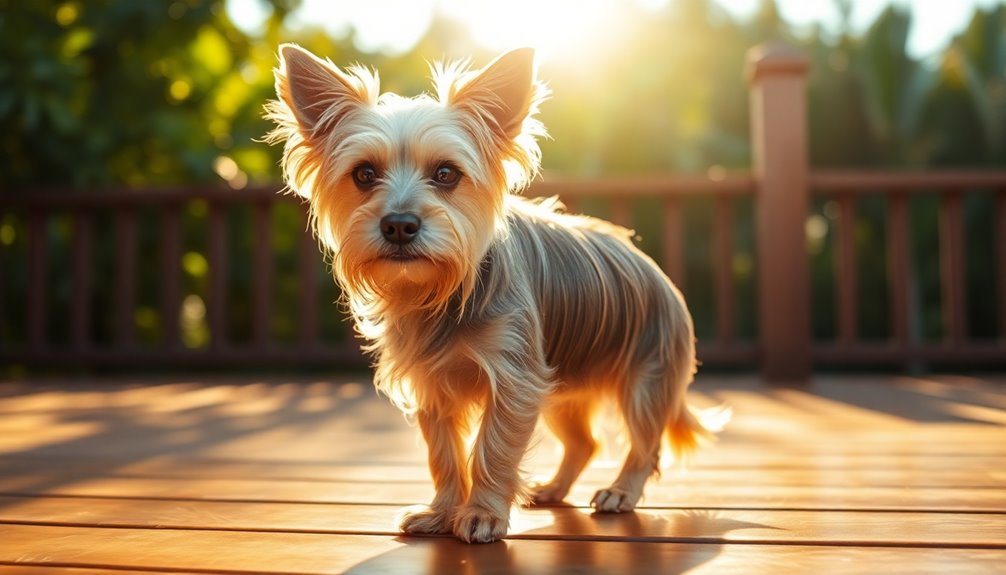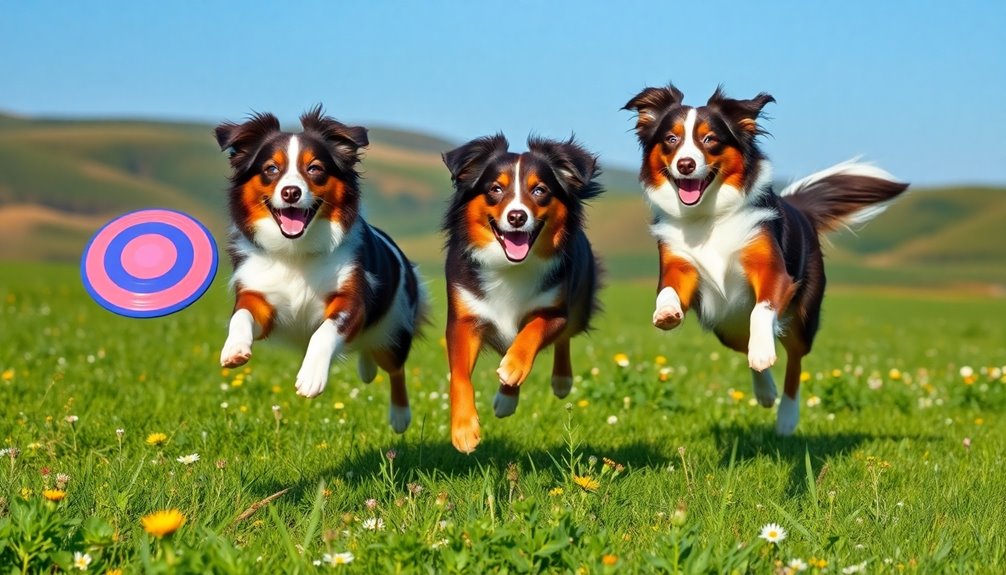Chow Chows, affectionately known as the "fluffy lion dog," are stunning companions that blend beauty with a fascinating history from ancient China. Standing 18-22 inches tall, these medium-sized dogs sport a unique blue-black tongue and a thick, double coat that requires regular grooming. Their temperament is distinct; they're independent and sometimes aloof, making them excellent watchdogs. With proper training and socialization, they can be loyal family members. Regular exercise and health check-ups are essential for their well-being. Curious about their grooming needs or living environment? You'll discover more insights that can help you decide if this breed fits your lifestyle.
Key Takeaways
- Chow Chows are medium-sized dogs known for their distinctive fluffy double coat and lion-like appearance.
- Their unique blue-black tongue sets them apart from other breeds and adds to their charm.
- Originating from China, they have a rich history as loyal guardians and companions.
- Chow Chows are known for their independence and strong-willed nature, making training a challenge.
- Their protective instincts and aloof demeanor contribute to their reputation as excellent watchdogs.
Introduction

Introducing the Chow Chow, you'll quickly notice its striking resemblance to a lion, thanks to its unique mane and regal demeanor. This medium-sized dog stands between 18 to 22 inches tall, with males typically weighing 45 to 70 pounds and females ranging slightly less. The Chow Chow's muscular build is complemented by its distinctive blue-black tongue and almond-shaped eyes, which add to its captivating appearance.
Despite their lion-like looks, Chow Chows have a temperament that's quite unique. They tend to be aloof, composed, and independent, often resembling the behavior of a cat rather than that of a dog. You might find that they aren't particularly enthusiastic about cuddling or hugging. Early socialization is essential due to their tendency to be fiercely protective of their family, as they can also show aggression towards other dogs and strangers, making socialization crucial from a young age.
Caring for a Chow Chow requires commitment, especially regarding grooming. Their double coat needs regular bathing and brushing to prevent matting, and you'll need to pay special attention to their eyes and facial folds.
History and Origin
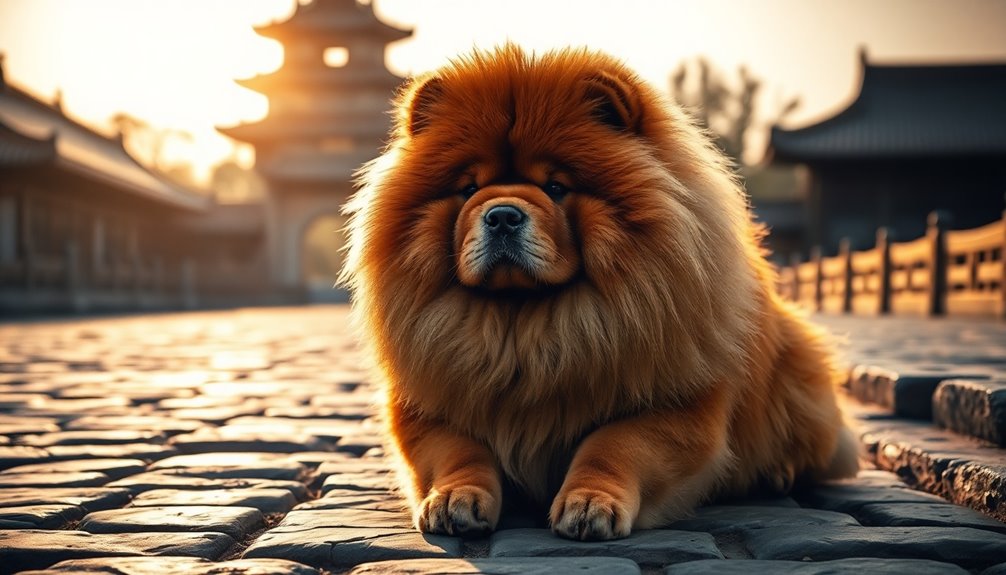
The Chow Chow's roots trace back to central China around 8,300 years ago, where they were bred for various roles.
These dogs served as loyal guardians, protecting livestock and possessions during the Han Dynasty.
Their strong protective instincts and unique appearance have made them a fascinating breed throughout history. Additionally, the Chow Chow is recognized as a basal breed, which predates many modern dog breeds.
Where and when the breed originated
Chow Chows, often recognized for their distinctive fluffy coats and lion-like appearance, trace their origins back to central China, where they first emerged around 8,300 years ago.
These dogs are associated with the indigenous breeds of Northern China and belong to one of the oldest dog lineages related to gray wolves in East Asia. Their development likely coincided with the rise of agriculture near the Yangtze River, where they were selected from local dog populations.
Historically, Chow Chows date back to the Han Dynasty (206 BC to 22 AD), supported by archaeological evidence like pottery and sculptures that show their presence over 2,000 years ago. Their distinct blue-black tongue is also mentioned in ancient Chinese literature, emphasizing their unique genetic traits.
They appear in Chinese literature and art, indicating their long-standing cultural significance. Initially bred for hunting and herding, these dogs also pulled sleds through swampy terrain, a fact noted by Marco Polo.
Their majestic appearance and utility made them symbols of prestige among Chinese nobility, reflecting their important roles in ancient society.
As you learn about their rich history, you'll appreciate how Chow Chows have shaped both Chinese culture and the lives of those who cared for them.
Guarding and Protection Duties
Guarding and protection duties have been integral to the Chow Chow's history, showcasing their natural instincts and versatility.
Originally, these dogs served as guardians in monasteries and households, protecting homes, farms, and even livestock. Their protective instincts made them ideal for guarding royalty, as they were often employed by kings and queens, living in palaces and treated like royalty themselves.
Chow Chows have a remarkable ability to sense changes in their environment, making them excellent watchdogs. They're naturally wary of strangers, which enhances their guarding capabilities. This behavior can sometimes be attributed to resource guarding tendencies that stem from their protective nature.
However, their independent and strong-willed nature can present training challenges. You'll need consistent, gentle training methods to harness their protective instincts effectively.
Socialization is crucial; exposing your Chow Chow to various people and situations helps them differentiate between friends and foes. While they can exhibit aggressive behavior towards perceived threats, proper socialization can mitigate this tendency.
In modern settings, Chow Chows can serve well as low-energy guard dogs, provided they receive adequate exercise and mental stimulation. Consulting a professional trainer can help you ensure that your Chow Chow meets your specific security needs.
Physical Characteristics

When you look at a Chow Chow, their impressive size and unique coat immediately catch your eye.
Weighing between 45 to 70 pounds and standing 17 to 20 inches tall, they boast a dense double coat that demands regular grooming. Their exercise needs are relatively low, requiring only 20 minutes of daily exercise, making them suitable for a laid-back lifestyle.
One of their most distinctive features is their striking blue-black tongue, setting them apart from other breeds.
Size, weight, and coat details
Known for their distinctive appearance, Chow Chows typically stand between 17 to 22 inches tall, with males generally being larger than females. Males usually reach heights of 18 to 22 inches, while females range from 17 to 20 inches.
In terms of weight, these dogs weigh between 50 to 75 pounds, with males averaging 55 to 71 pounds and females around 44 to 60 pounds. However, some Chow Chows can weigh up to 100 pounds or more, reflecting significant individual variations. Chow Chows are considered fully grown at 16 months, reaching a stable weight of at least 50 pounds by this age.
Chow Chows come in two coat types: rough and smooth. The rough coat is dense, plush, and coarse, standing away from the body, while the smooth coat is shorter and also off-standing. The rough coat features a medium to medium-long outer layer with a soft, thick undercoat.
You'll notice abundant fur around the neck and chest, forming a distinctive ruff, along with a well-plumed tail. Their coats come in a variety of colors, including red, black, blue, cinnamon, and cream.
Grooming is essential, especially for rough-coated Chow Chows, requiring daily attention to prevent tangles and maintain their unique look.
Blue-Black Tongue Coloration
From the moment they're born, Chow Chows are recognized for their striking blue-black tongues, a hallmark of the breed. This unique coloration, caused by high levels of melanin produced by melanocytes, is present from birth and remains consistent throughout their lives.
While the blue-black tongue is the breed standard, you might notice some Chow Chows with pink, spotted, or multicolored tongues, though these variations are less common.
Genetically, the blue-black tongue arises from dominant genes associated with melanin production, such as ASIP and PDPK1. Interestingly, if a Chow Chow inherits even one copy of the gene, it will have a blue-black tongue.
As your Chow Chow ages, it's normal for them to develop pink spots on their tongue, reflecting typical aging changes. Additionally, the blue-black tongue is a characteristic that has been highly valued throughout history, making these dogs coveted companions.
The precise origins of this unique tongue coloration are still debated; some theories suggest it served as protection against evil spirits or UV rays, while others link it to folklore and good fortune.
Regardless, the blue-black tongue remains a cherished feature among breeders and enthusiasts, symbolizing the distinctive charm of the Chow Chow.
Temperament and Personality
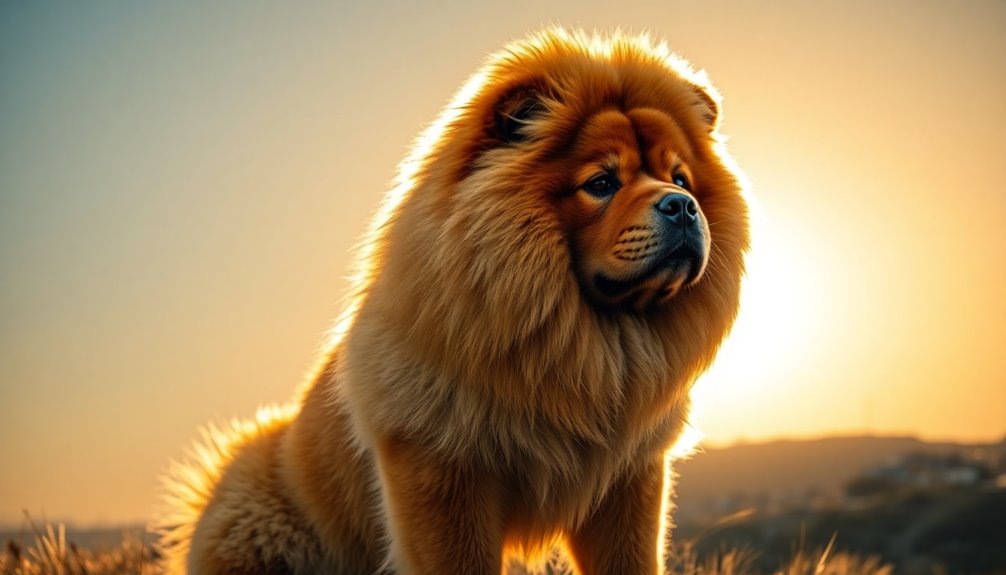
When it comes to temperament, Chow Chows are known for their independence and strong-willed nature. This unique personality makes them better suited for families with older children or individuals who appreciate a loyal companion without constant affection. They can also coexist well with other pets, but proper socialization is key to ensuring harmonious interactions. Additionally, Chow Chows are considered one of the cleanest dog breeds, which complements their dignified demeanor.
Independent and Strong-Willed
As you get to know the Chow Chow, you'll quickly realize it embodies an independent and strong-willed temperament. This breed is highly intelligent but values its independence, often making its own decisions if not properly guided.
You may find that traditional training methods don't always work, as Chow Chows can be stubborn and resistant to authority. Instead, they respond best to positive reinforcement, so treats and praise go a long way in gaining their cooperation.
Chow Chows can appear aloof or distant, especially around strangers and other animals. They prefer to mind their own business and don't seek external validation, which adds to their unique charm. Their protective instincts mean they're naturally suspicious of newcomers, making them excellent watchdogs. However, without proper socialization, they might become wary or defensive.
To maintain a strong bond, you'll need to establish consistent training and socialization from an early age. Remember, Chow Chows don't tolerate physical punishment; approach training with patience and respect.
With the right guidance, you'll find that their strong-willed character can make them incredibly loyal and dignified companions.
Suitability for families, individuals, or other pets
The Chow Chow can be a wonderful addition to the right household, showcasing loyalty and affection toward its human family. If you have children, early socialization and proper training are essential for fostering a bond between them and your Chow Chow. Couples who work together often have higher satisfaction, much like how teaching your kids to respect the dog's boundaries can lead to a harmonious household.
Teach your kids to respect the dog's boundaries and avoid rough play. With the right approach, a well-socialized Chow Chow can thrive in a busy, loving family environment. House training is typically easy due to the breed's natural cleanliness, which can further ease the integration into family life.
When it comes to strangers, Chow Chows tend to be aloof and may take some time to warm up. Proper introductions by you can help them feel more comfortable. While they're not typically aggressive, they can be protective of their family. Much like in relationships, the importance of communication about privacy preferences can aid in the dog's comfort level with new people.
As for other pets, Chow Chows can coexist peacefully with them, including cats. Their compatibility largely depends on how you raise and introduce them. Neutral ground meetings are effective for assessing their suitability with other animals. If socialized properly, Chow Chows can form strong friendships and be gentle with smaller pets. Couples who travel together often report that shared experiences strengthen their relationships, similar to how these dogs can bond with other pets when introduced in a positive manner.
Health and Lifespan
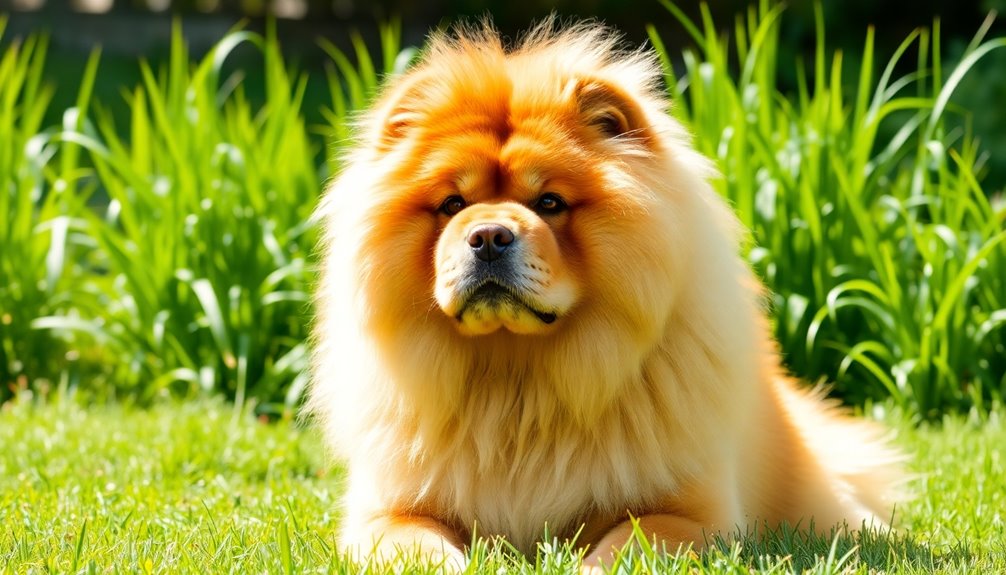
When it comes to your Chow Chow's health and lifespan, you'll want to be aware of their average life expectancy of around 12.1 years. This breed is prone to certain health issues, including hip dysplasia and eye problems, so keeping up with regular vet visits is essential. Additionally, a nutritious diet and regular exercise are vital for maintaining health and preventing obesity in Chows.
Typical lifespan of the breed
For Chow Chows, a typical lifespan ranges between 8 to 12 years, although with proper care, some can live up to 15 years. Their longevity is influenced by various factors, including genetics and responsible breeding practices.
You'll want to ensure your Chow Chow comes from a reputable breeder to improve their chances of a healthy life.
A balanced diet rich in essential nutrients is crucial. Tailor their meals based on age, size, and activity level to support their health. Regular exercise helps maintain their physical and mental well-being, so incorporate moderate activity into their routine. Don't forget about regular veterinary check-ups, as quality healthcare significantly impacts lifespan. Additionally, regular vet visits can aid in early detection of common health issues that may arise.
Creating a safe and comfortable home environment is also important. Minimize stress by providing stable surroundings and plenty of social interaction.
Keep an eye on their thick fur to prevent overheating, and address any signs of separation anxiety. Regular grooming and dental care will aid in their overall health, too.
Common health concerns or genetic predispositions
Chow Chows face several common health concerns that can impact their quality of life and longevity. One significant issue is musculoskeletal problems like hip and elbow dysplasia, which can lead to pain and mobility challenges. Rapid growth and high-calorie diets often exacerbate these conditions, so it's essential to monitor their weight. Health screening for hereditary conditions is crucial to identifying potential issues early and improving their overall health.
Eye problems are also prevalent in this breed, with conditions such as eyelid entropion affecting up to 50% of Chow Chows. Cataracts, glaucoma, and distichiasis can further impair their vision, making regular veterinary check-ups crucial.
Dermatological issues like atopic dermatitis and alopecia X are common, and Chow Chows also face a higher risk of autoimmune conditions like pemphigus foliaceus.
Additionally, they're predisposed to thyroid problems, stomach cancer, gastric torsion, diabetes mellitus, and pyometra, especially in females.
Being aware of these genetic predispositions allows you to take proactive steps in your Chow Chow's care. Regular veterinary visits, a balanced diet, and attention to their health can help mitigate these concerns and improve their overall well-being.
Tips for maintaining health and wellness
Maintaining your Chow Chow's health and wellness is essential for ensuring a long, happy life. Start with regular veterinary care; schedule yearly check-ups for adults and more frequent visits for puppies and seniors. Ensure your vet conducts thorough physical exams and keeps vaccinations up to date, starting as early as 6-8 weeks for puppies. Regular vet check-ups can help with early detection of breed-specific health issues.
A balanced diet is crucial. Feed your Chow high-quality proteins, like lean meats and fish, and choose premium dog food tailored for their age. Control portions to maintain a healthy weight and consider home-cooked meals with a veterinary nutritionist's guidance.
Grooming plays a significant role too. Brush your Chow daily, especially during shedding seasons, and bathe them every 4-6 weeks. Don't forget regular ear cleaning and dental care to prevent infections and plaque build-up.
Finally, provide exercise and mental stimulation. Aim for 20-30 minute walks twice a day and engage in interactive play sessions. Use puzzle toys and rotate their toys to keep them mentally active. Avoid outdoor activities during peak heat to prevent overheating, ensuring your furry friend stays safe and healthy.
Care Requirements
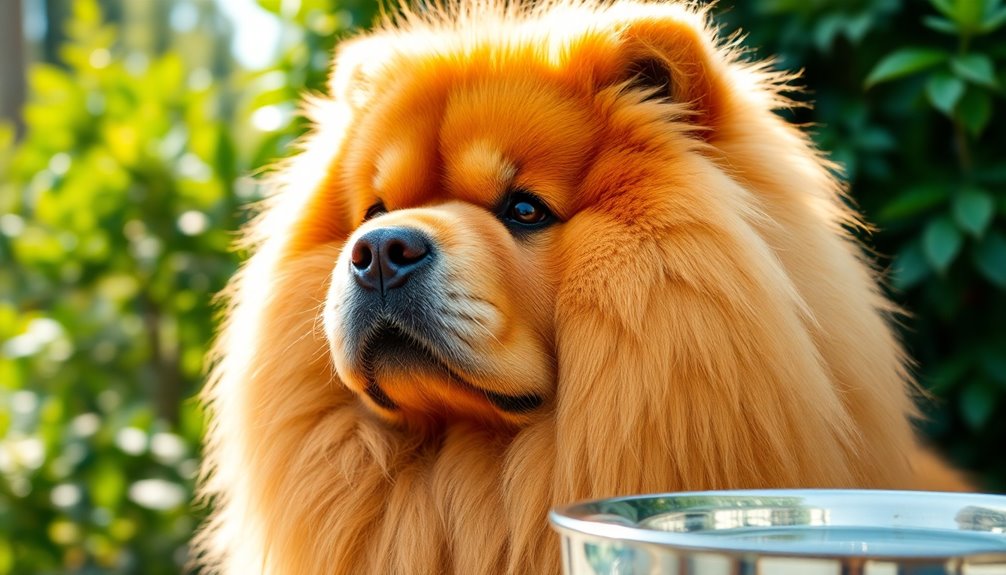
Caring for your Chow Chow involves regular brushing to keep that beautiful coat in top shape and prevent matting. It's important to remember that during heavy shedding seasons, daily brushing becomes essential to manage their coat effectively. You'll also need to ensure they get enough exercise to manage their energy levels and maintain a healthy weight. Lastly, focusing on a balanced diet will help support their overall health and coat quality.
Regular Brushing Required
To keep your Chow Chow's luxurious coat in top shape, regular brushing is essential. Aim to brush your dog 2-3 times a week; however, daily brushing is ideal, especially during shedding seasons. This routine helps remove dead hair, prevents matting, and distributes natural skin oils, keeping the coat shiny while reducing skin problems. Regular brushing also helps prevent issues with sensitive skin that Chow Chows are prone to.
Use a slicker brush to tackle loose fur and prevent tangles. A pin brush works wonders for the outer coat, while an undercoat rake is perfect for removing dead hair from the thick undercoat. For stubborn knots, a wide-toothed comb is your best friend, especially when paired with a detangling solution.
Focus on areas prone to tangling, like the neck, legs, and tail. Brush the ruff around the neck outwards from the skin and give the plumed tail regular attention to prevent mats. Don't forget to brush behind the ears, under the legs, and around the collar.
During heavy shedding seasons in spring and fall, increase your brushing frequency to manage the loose fur and help your Chow Chow adjust to changing temperatures.
Exercise requirements and energy levels
When it comes to keeping your Chow Chow happy and healthy, regular exercise is key. Aim for 30 to 60 minutes of daily exercise, but spread it out over multiple sessions to prevent overheating.
Chow Chows prefer moderate activities like leisurely walks, playtime in a secure yard, or short hikes in cooler weather. Avoid high-impact exercises and keep them indoors during hot or humid conditions, as their thick fur makes them sensitive to heat.
With a medium energy level, Chow Chows aren't high-energy dogs, so they benefit from gentle physical activities rather than intense workouts. They tolerate cold weather well, and after exercise, they'll need a quiet, comfortable space to relax. Regularity in exercise promotes overall health and well-being in your Chow Chow.
Regular exercise aids in weight management, joint health, and cardiovascular fitness while also keeping behavioral issues at bay.
Be cautious during hot weather; exercise during the cooler parts of the day and always provide plenty of water and shade. Swimming can be a fun low-impact option, but introduce it gradually.
A well-exercised Chow Chow is calm, content, and maintains a healthy weight, ensuring a happy companion by your side.
Feeding tips and diet recommendations
Proper nutrition is vital for your Chow Chow's health and well-being. Start by providing high-quality protein from sources like chicken, beef, or lamb to support muscle maintenance. Incorporate healthy fats, such as omega-3 and omega-6 fatty acids from fish oil or flaxseed oil, for energy and a shiny coat. Choose easily digestible carbohydrates, including brown rice, oats, or sweet potatoes, to aid digestion and provide fiber. Ensuring a balanced diet that meets nutritional requirements is essential for overall health. Additionally, maintaining a proper credit score can help you afford high-quality pet food and veterinary care.
For adult Chow Chows, feed two meals a day to keep their energy levels steady. Puppies, on the other hand, need three to four meals until six months old, before transitioning to two meals. Be mindful of portion control to prevent obesity, adjusting based on age, weight, and activity level.
Opt for high-quality dog food with real meat as the first ingredient, avoiding fillers and artificial additives. If your Chow Chow has grain sensitivities, consider a grain-free diet, ensuring all nutrients are included.
Always steer clear of human foods that are toxic, like chocolate and onions. Lastly, ensure your dog has constant access to fresh, clean water for optimal hydration.
Training and Socialization

Training your Chow Chow can be a challenge due to their stubbornness, so you'll need to approach it with patience. Gradually introducing them to new experiences is crucial for building confidence and reducing any leash reactivity or aggression. Starting your training early and establishing consistent expectations will greatly aid in their learning process.
Stubbornness May Hinder Training
Chow Chows are notoriously stubborn, which can significantly hinder their training. Their independent nature means they often prefer to think for themselves rather than simply obey commands. You might find that they're not inclined to follow your lead unless they see a good reason to do so. This independence makes patience and persistence essential during training.
To tackle their stubbornness, focus on positive reinforcement techniques. Harsh discipline can backfire, leading to mistrust and even aggression. Instead, reward desired behaviors with treats, praise, or playtime. Consistency is also crucial; establish a routine for feeding, walks, and training sessions. Always use the same commands and hand signals, and ensure everyone in your household is on the same page. Additionally, starting socialisation from a young age can help foster better adaptability(better adaptability) to new experiences.
When managing training sessions, keep them short—around 5 to 10 minutes—to maintain your Chow Chow's interest. Use a firm, confident voice without shouting. If you hit a stubborn streak, take a break to reassess your approach.
If training becomes overwhelming, don't hesitate to seek professional help. With the right techniques and consistency, you can work through their stubbornness effectively.
Introduce Gradually to New Experiences
Introducing your Chow Chow to new experiences gradually is essential for their development and well-being. Start by exposing your dog to new environments in controlled settings, like your backyard or a quiet park.
Begin with small, manageable exposures to avoid overwhelming them, and slowly increase the level of exposure as they become more comfortable. Try various locations, such as pet stores or friends' houses, ensuring each new environment offers positive experiences.
When introducing your Chow Chow to new people or animals, use positive reinforcement techniques like treats and praise. Introduce them to one new person or animal at a time, ensuring interactions are calm and friendly.
Involve different family members in this process and teach children how to interact properly with the dog. Additionally, engaging in daily exercise helps reduce boredom and pent-up energy, making your Chow Chow more receptive to new experiences.
Consider enrolling your Chow Chow in controlled socialization settings, like puppy classes, where you can manage experiences to keep them positive. Use crate training to create a secure environment, and incorporate leash training in public settings.
Remember to expose your Chow Chow to various sounds and situations throughout their life to maintain their social skills and prevent fearfulness.
Leash Reactivity and Aggression
Leash reactivity and aggression can be challenging behaviors for any dog owner, especially with a Chow Chow's strong personality. This reactivity often arises from emotional responses to triggers like other dogs, people, or objects, resulting in barking, pulling, or aggression while on a leash.
To address leash reactivity, it's vital to change your dog's emotional association with these triggers. Use positive reinforcement techniques, rewarding your Chow Chow with treats when they encounter a trigger calmly. Teaching them to perform an alternative behavior, such as looking at you, can help redirect their reaction. Additionally, establishing expectations through training can enhance communication between you and your dog, fostering a better understanding of desired behaviors. Regular practice of mindfulness techniques can also help reduce anxiety in both you and your dog during training sessions.
Short, frequent training sessions keep your dog engaged and reduce frustration. Consistency in commands and hand signals is key, so ensure everyone in your household follows the same guidelines. Avoid punishing your dog for pulling; this can heighten anxiety and worsen the behavior.
Additionally, early socialization plays a crucial role in preventing leash reactivity. Slowly expose your Chow Chow to various environments, people, and animals to boost their confidence.
Ideal Living Environment
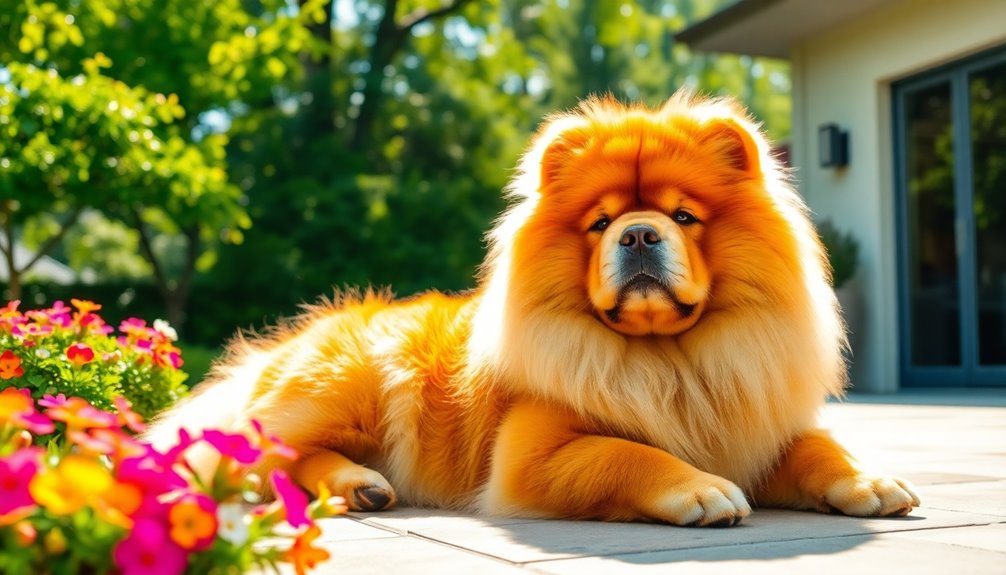
If you're considering adding a Chow Chow to your home, you'll want to ensure you have a spacious environment with secure fencing. These dogs thrive in cooler climates and need plenty of room to roam and play safely. A well-maintained yard and a comfortable living space will keep your fluffy companion happy and healthy. Additionally, it's important to consider their medium exercise needs to ensure they remain fit and healthy.
Spacious Home With Secure Fencing
Creating a spacious home with secure fencing is crucial for a Chow Chow's well-being and happiness. These dogs thrive in environments where they've plenty of indoor and outdoor space to explore. A large garden allows your Chow Chow to feel secure and comfortable while providing ample room for movement.
While they can adapt to smaller spaces if exercised regularly, having enough room to roam freely is essential. Chow Chows' protective instincts make secure fencing vital for preventing your dog from escaping and ensuring their safety. It protects your Chow Chow from external threats, maintains their territorial boundaries, and minimizes interactions with unwanted visitors or animals. A well-fenced yard reduces the risk of your dog chasing smaller creatures, which can lead to unwanted incidents.
Additionally, a quiet and stable home environment is ideal for a Chow Chow. They appreciate being the center of attention, so it's best to introduce them to a home without small animals and minimize noise and unfamiliar faces.
Regular training and socialization are necessary to nurture a trusting relationship. Ultimately, by creating a spacious, secure, and calm environment, you'll help your Chow Chow thrive and lead a happy life.
Prefers Cooler Climates
Chow Chows are well-suited for cooler climates, thanks in large part to their origins in northern China, where they adapted to endure harsh winters. Their thick, double coat, comprised of a woolly undercoat and a rough outer layer, provides excellent insulation against the cold.
You'll find that Chow Chows naturally tolerate lower temperatures better than many other breeds, but you'll still need to monitor them in extreme conditions to ensure they're comfortable.
While they thrive in cooler weather, Chow Chows can adapt to various climates, though they prefer indoor temperatures in winter between 68-72°F (20-22°C). They enjoy spending time outdoors when it's chilly and often seek out sunny spots indoors for warmth.
Remember, during cold months, they need access to a warm, dry shelter. Additionally, their unique anatomy aids in heat conservation, which helps them manage cold temperatures effectively.
Regular exercise is crucial even when it's cold, so consider shorter, more frequent walks and indoor play sessions. Protect their paws from ice and salt during winter walks.
You'll likely notice they're more active and playful in cooler weather, but avoid letting them sleep outdoors during winter; they need a cozy indoor sleeping area to stay comfortable.
Ancient Breed Used for Pulling

You might be surprised to learn that the Chow Chow is one of the first dog breeds ever to be registered, showcasing its long-standing history. This ancient breed not only served as a loyal companion but also played a vital role in pulling sleds and transporting goods across rugged terrains. In fact, historical records indicate that Chow Chows were used for pulling sleds as early as the late 1200s, demonstrating their versatility. Plus, its distinctive look even inspired characters in popular culture, like those in "The Lion King."
First Breed to Be Registered
The Chow Chow stands out as one of the first breeds to be registered, showcasing its rich history that dates back centuries.
Introduced to Europe in the early 1800s, the first Chow Chows arrived in England around 1820, likely brought by employees of the Dutch East India Company.
In 1781, the first Chow Chow made its way to England, marking a turning point for the breed.
Initially kept in zoos, they were showcased as exotic creatures, labeled "the Wild Dogs of China" by the Zoological Society of London. Additionally, the breed has a distinctive bluish-black tongue, which sets it apart from other dog breeds.
Chow Chow in The Lion King
Celebrating its ancient lineage, the Chow Chow's unique characteristics have captured the imagination of many, including filmmakers and storytellers. In "The Lion King," you mightn't see a Chow Chow on screen, but its majestic lion-like mane and dignified stance embody the regal essence of the film's characters.
Originally bred by Mongolian tribes over 2,000 years ago, these dogs weren't just companions; they also served as hunting, herding, and guarding dogs. Their strength made them suitable for pulling sleds and carts, showcasing their versatility. The breed's historical significance is highlighted by the fact that Queen Victoria popularized it in the 19th century.
With a blue-black tongue and deep-set eyes, the Chow Chow stands out among canines. Their strong-willed nature can be likened to the fierce independence of the film's protagonists. Although not pack-oriented, Chow Chows can form strong bonds with their owners, much like the loyalty seen in the relationships of "The Lion King."
This ancient breed's cultural significance runs deep, influencing everything from art to architecture. So, while you may not spot a Chow Chow in the savannah, its spirit resonates with the pride and strength depicted throughout this beloved story.
Chow Chow's Unique Grooming Needs
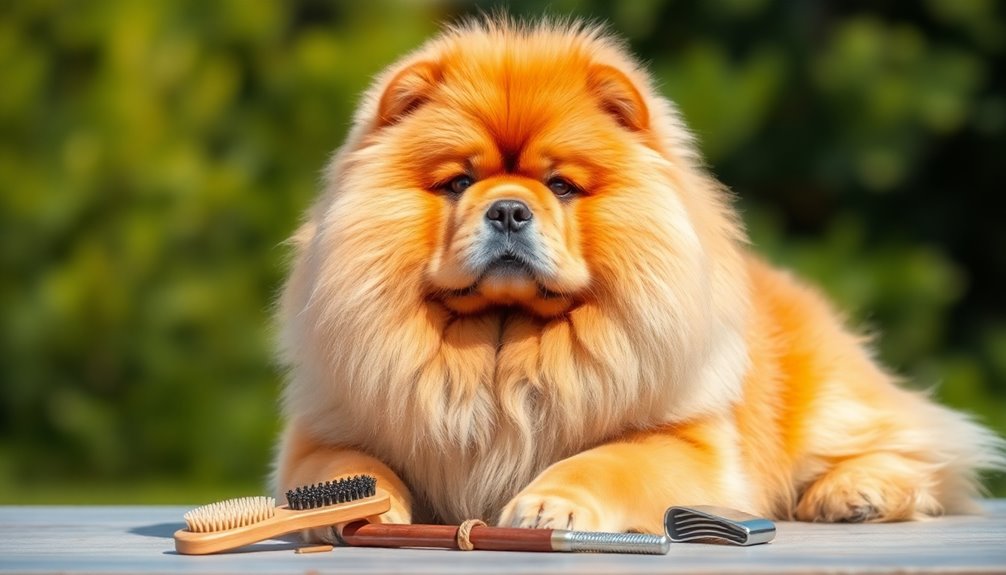
Caring for a Chow Chow isn't for the faint of heart, as their grooming needs can be quite demanding. You'll need to commit time to regular brushing and bathing, especially during shedding seasons. Proper tools like a long-pin slicker and de-shedders are essential for managing their thick double coat. If you're not prepared for this level of upkeep, owning a Chow Chow mightn't be the best choice for you.
Not Ideal for Novice Owners
Owning a Chow Chow can be a rewarding experience, but the unique grooming needs of this breed can pose significant challenges for novice owners.
These dogs are known for their independent nature, making training more difficult and requiring consistent commands and patience. If you're not experienced, you might struggle with their stubbornness and need for creative training methods to keep them engaged.
Chow Chows have a thick double coat that demands daily brushing, especially during shedding seasons. Neglecting this can lead to matting, tangling, and potential skin issues, which can be uncomfortable for your dog. Their thick double coats also serve to protect them against extreme weather conditions, further emphasizing the importance of proper grooming.
Additionally, you'll need to bathe them every 6-8 weeks to maintain their coat's natural oils. Regular nail trimming and ear cleaning are essential for their overall health.
Moreover, Chow Chows are prone to various health issues that can be costly to manage, making them better suited for experienced owners who understand the financial and time commitments involved.
Without the right expertise in handling their grooming and training, you may find the experience overwhelming, which could affect both you and your furry companion.
Grooming Demands and Time Commitment
Grooming demands for a Chow Chow are significant and require a dedicated time commitment. You'll need to brush your Chow at least once a week, or daily during shedding seasons. A slicker brush is essential for removing loose fur and preventing matting, while a pin brush helps smooth the outer coat.
Don't forget to use a metal comb to check for any tangles or mats, brushing from the skin to reach the undercoat effectively. Regular grooming, especially establishing a daily brushing routine, helps prevent matting and hotspots in the coat.
Bathing is another crucial aspect; aim for every 6-8 weeks, using dog-specific shampoo. If necessary, you can bathe more frequently, but ensure you're using the right products and techniques. Always start from the neck and work your way down, avoiding the face and ears.
Regular trimming of excess hair on the feet and maintaining short nails is key to your Chow's comfort and health. Clean their ears weekly and brush their teeth daily for optimal oral hygiene.
Lastly, keep an eye on their skin and consult a vet if you notice any changes. Staying consistent with grooming will help your Chow Chow look and feel their best.
Frequently Asked Questions
Are Chow Chows Good With Children and Other Pets?
When considering if a dog is good with children and other pets, socialization and training are key.
You need to introduce your dog to kids slowly, allowing it to adapt to their unpredictable behavior. Supervise interactions closely to prevent misunderstandings.
For pets, assess individual personalities and introduce them in neutral settings. Consistent rules and positive reinforcement help ensure a harmonious environment for both children and pets, fostering respect and understanding among all.
How Much Do Chow Chows Typically Weigh?
Chow Chows typically weigh between 44 to 71 pounds, depending on whether they're male or female.
Males generally weigh more, ranging from 55 to 71 pounds, while females usually weigh between 44 to 60 pounds. Some can even exceed 100 pounds.
They grow rapidly during their first year, reaching their full size by around 16 months.
It's important to monitor their weight to ensure they stay healthy and fit throughout their lives.
Do Chow Chows Shed a Lot?
Yes, Chow Chows shed quite a bit, especially during seasonal changes.
You'll notice heavier shedding in spring and fall as their coats adjust to temperature changes.
To manage this, regular grooming is key—brush them at least twice a week to keep their fur healthy.
A balanced diet can also help minimize excessive shedding.
If you see unusual or extreme shedding, it might be time to consult a veterinarian for potential health issues.
What Is the Average Lifespan of a Chow Chow?
The average lifespan of a Chow Chow typically ranges from 8 to 14 years, with some living up to 15 years.
Factors like genetics, diet, regular exercise, and healthcare significantly influence their longevity.
To help your Chow Chow live a longer, healthier life, ensure they receive a balanced diet, regular vet check-ups, and plenty of mental stimulation.
Creating a safe environment and avoiding extreme temperatures also contributes to their well-being.
Are Chow Chows Prone to Any Specific Health Issues?
Yes, you'll find that some dogs are prone to specific health issues.
Common concerns include allergies, eyelid entropion, and hip dysplasia.
Genetic conditions like degenerative myelopathy and thyroid function issues can also arise.
Additionally, be aware of risks for infections and digestive problems.
Regular veterinary check-ups and screenings can help catch these issues early, ensuring your furry friend stays healthy and happy throughout their life.
Conclusion
In conclusion, the Chow Chow is a fascinating breed with a rich history and unique characteristics. Their lion-like appearance and distinct personalities make them a beloved companion for many. By understanding their grooming needs and training requirements, you can provide a happy and healthy environment for your Chow. Whether you're drawn to their fluffy coats or loyal nature, this breed can be a wonderful addition to your home, as long as you're ready for the commitment they require.

